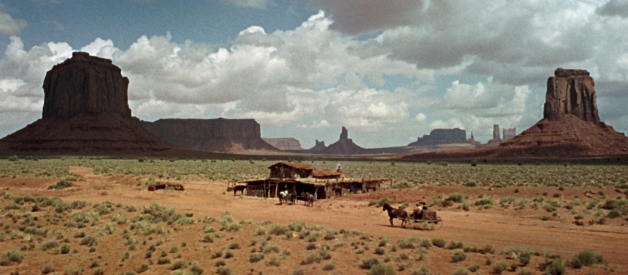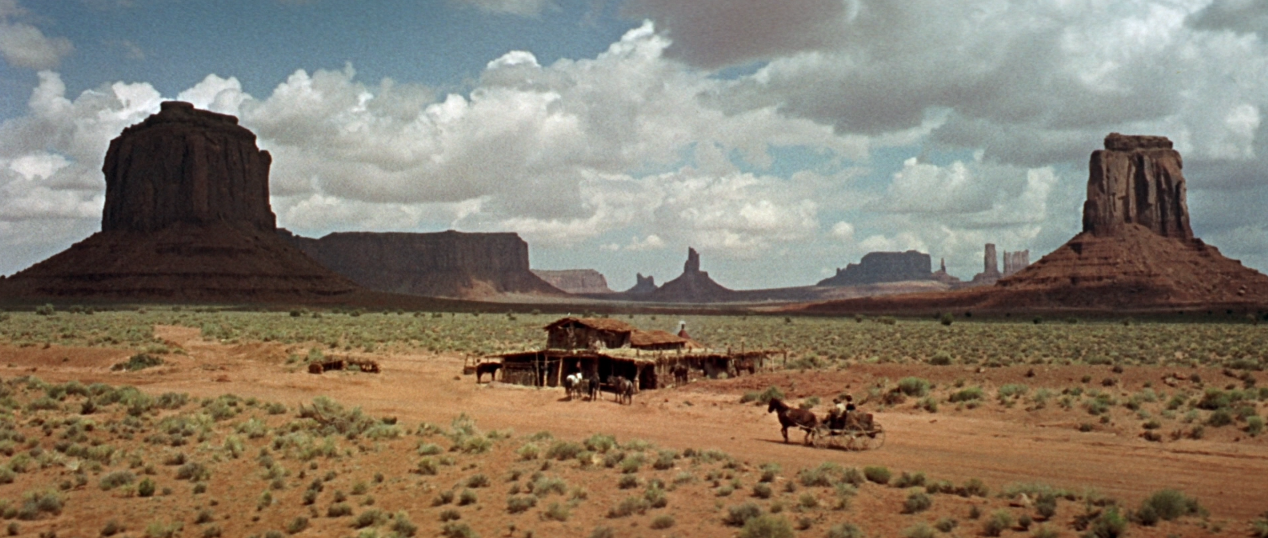
The breadth of the western genre can make it difficult to decipher where you should start when viewing its vast filmography, especially if you?re unfamiliar with it. From silent shorts to colossal epics, there are countless kinds of westerns. There are also a great number of revisionist westerns that pull back the curtain to more accurately portray the time and provide much-needed historical context. The genre has greatly evolved over its century-long existence. It began with morality plays in the silent era pitting white-hat cowboys against black-hat outlaws, and audiences cheered for the hero, who always triumphed. Western films are the greatest American cultural export, an entirely unique creation from some of cinema?s earliest filmmakers. However, the real western frontier was not as glamorous or romantic as it has been portrayed. America?s foundation is built on deceit, robbery, and genocide, a fact that cannot be ignored. It is pertinent to accept that the depictions of the western genre are romanticized fictions that unfortunately cast aside the rotten truths of our history to bolster those who forged this nation through often abhorrent means.
Never forgetting that, one can accept the western genre for what it is meant to be: a celebration of the greatest American ideals by focusing on a time when the American spirit flourished. The western created a genuine American mythology that is both inspirational and entertaining. The following list will be a guide that represents not only the best the genre has to offer, but also a recommended order in which to watch them to gain a better understanding of the western genre as a whole. This list is not a ranking of the films, so the order does not speak to quality. As always, definitive lists of films are subjective, as this is only one opinion, but hopefully it is one that will aid in your enjoyment of the genre, and expose you to a greater understanding of these seminal films.
1. Stagecoach (1939)
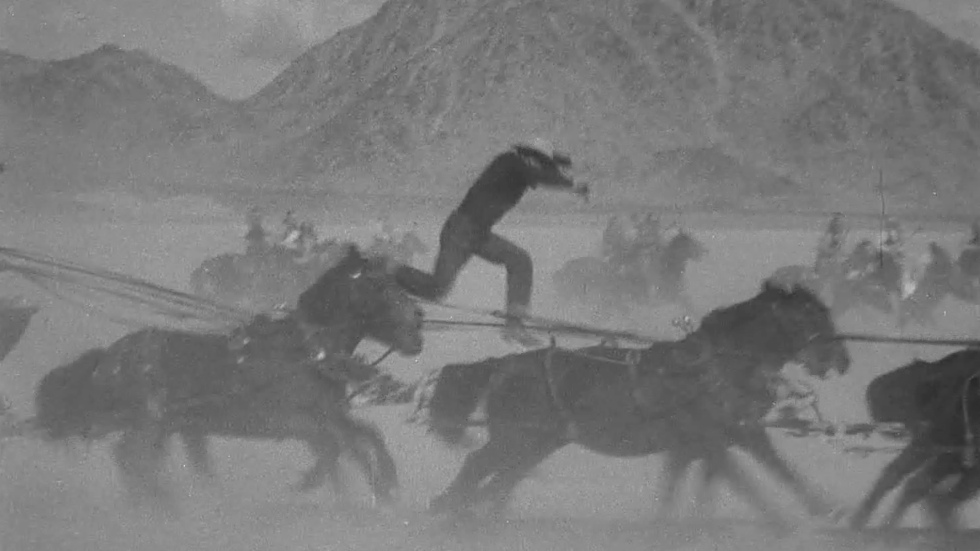 Stagecoach. Dir. John Ford.
Stagecoach. Dir. John Ford.
The western existed for more than three decades before this first selection, but Stagecoach remains the earliest western with the greatest impact. With Stagecoach, director John Ford took the banal stereotypes of the genre and injected them with energetic characters, emotional depth, and thematic resonance that the B-list films before it lacked. Stagecoach single-handedly saved the western from falling into the depths of obscurity and redefined the genre as a whole. It serves as a quintessential western film in terms of theme, character archetypes, setting, and action. Stagecoach is also remarkable for the breakout performance of the western genre?s most beloved actor, John Wayne. Here, Wayne bursts onto the screen in a commanding dolly shot that establishes his dominating presence within the film and the genre itself. Wayne plays the Ringo Kid, an outlaw who has broken out of jail to exact revenge for the murder of his family. Ringo is unlike the outlaws normally seen in the genre though, as he is likeable, charming, and chivalrous. The plot of Stagecoach set many standards for the western, like an arduous journey through dangerous Indian territory and a climactic standoff between Ringo and his adversaries. Both of these types of stories are western staples, yet few have executed it as well as Ford did here. The film?s timeless portrayal of a band of misfits thrown together on the journey through the gorgeous Monument Valley has become one of the definitive images of the American west. Stagecoach is the ideal starting place for anyone looking to understand the western genre. It is both incredibly accessible despite its age and a perfect portrait of the characters, settings, and themes that define the genre.
A more in depth look at Stagecoach?s influence and legacy within the western genre can be read here.
2. Rio Bravo (1959)
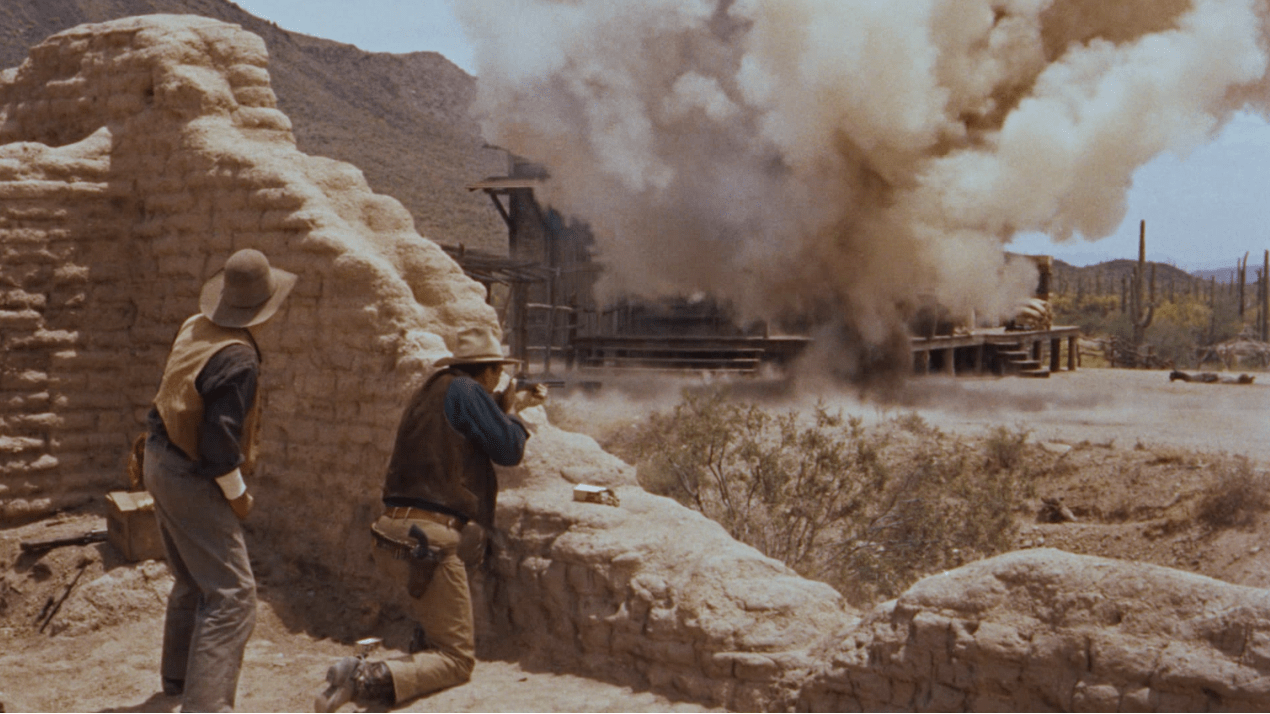 Rio Bravo. Dir. Howard Hawks.
Rio Bravo. Dir. Howard Hawks.
From an outlaw to a sheriff, again John Wayne shines the poster boy of the west. Notably, this film is the only one on this list not in chronological order. This is because, unlike other westerns of the 1950s, which began to explore the changing sensibilities of what defines a hero, Wayne and director Howard Hawks made Rio Bravo harken back to the ideal western hero as an unwavering icon of integrity. The opening sequence of the film brings you back to an earlier time, as the cast of characters are introduced in a silent-film style scene that is both dynamic and expressive. Wayne?s sheriff John T. Chance enlists the help of a motley crew of townsfolk to defend themselves from the approaching wrath of a prisoner?s indignant brother. Rio Bravo supports the idea that people will fight for what is right, and band together when they are needed most. Wayne?s character, like many of his others, stands as a pillar of morality; he remains fearless in the face of impending conflict. As in many Hawks films, themes of masculinity are prevalent, whether it is the assertive presence of Wayne as he dominates the film in his usual manner, the humble vulnerability of Dean Martin as ?Dude,? constantly fighting an alcohol addiction and a broken heart, the firecracker-like cockiness of Ricky Nelson?s youthful Colorado, or the ever enjoyable Walter Brennan as the old man, Stumpy, who can still go toe-to-toe with all the other boys. Rio Bravo is a simpler western that doesn?t comment on the genre, but instead perfectly encapsulates the fun and fantasy that one thinks of when the genre comes to mind. Characters are the focus of the film, as the cast draw you into their community who, as a unit, fight together for the greater good. Rio Bravo presents America at its best, where everyone bands together in the name of freedom and justice.
3. Red River (1948)
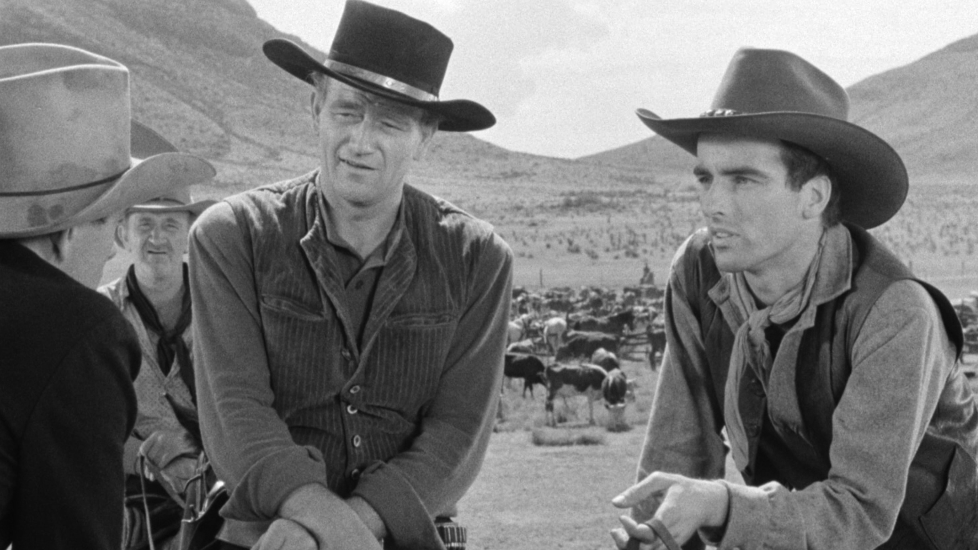 Red River. Dir. Howard Hawks.
Red River. Dir. Howard Hawks.
Very few westerns are about actual ?cowboys,? and Red River is the greatest of them by a large margin. Hawks and Wayne team up for the first time in this grand-scale western that sees Wayne as an ambitious cattle herder named Dunson attempting to drive his cattle over 1,000 miles from Texas to Missouri. Wayne?s character is tyrannical, though, and the callous manner in which he treats his men soon causes tension within the ranks, leaving many to question his leadership. When a mutiny breaks out, Dunson is overthrown and replaced by his surrogate son, Matt (Montgomery Clift), whom he swears vengeance upon. Revenge stories are common within the western genre, but Red River makes for one that is both captivating and conflicting. The struggles of both Dunson and Matt are sympathetic, so their feud can only end tragically. The cold intensity of Wayne?s performance certainly adds to this; his oath of vengeance is delivered with the utmost of certainty: ?You should?ve let ?em kill me, ?cause now I?m gonna kill you. I?ll catch up with you. I don?t know when, but I?ll catch up. Every time you turn around expect to see me? ?cause one time you?ll turn around, and I?ll be there. I?m gonna kill you, Matt.? With Red River, Hawks begins to question the morality of the western hero, and plays with the idea of how they are defined. Dunson is by no means a villainous character, though he is perhaps the closest Wayne ever came to portraying one. His ambitions are noble, and his methods as a leader are shown to be effective and well-intentioned, despite their intensity. The film begins with Dunson as the authoritative character, but then removes him from this position and asks the audience to consider if those we perceive as heroes are always in the right. If the burning question at the center of the western genre is ?What defines a hero?? then Red River is the match that started the fire.
4. High Noon (1952)
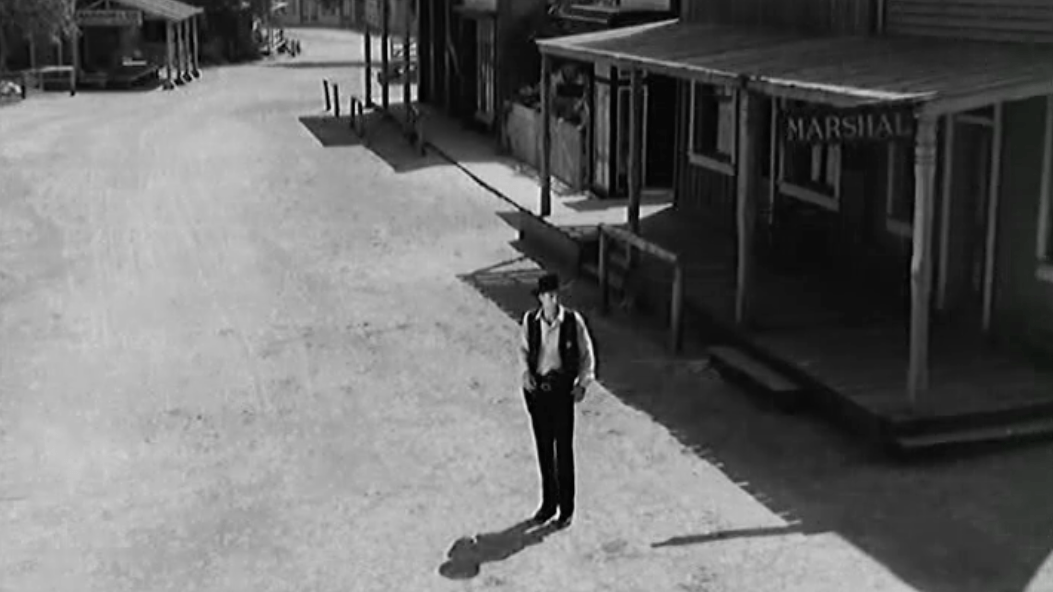 High Noon. Dir. Fred Zinnemann.
High Noon. Dir. Fred Zinnemann.
The Duke was, of course, not the only great star of the western genre. Many of Hollywood?s other golden boys took their turns in the saddle as well. James Stewart starred in great westerns like Winchester ?73 (1950), while Henry Fonda played iconic western characters like Wyatt Earp in My Darling Clementine (1946). Next to Wayne, though, the most iconic western star of the time was Gary Cooper. Cooper made a career out of playing refined heroic characters, especially in the western genre. Early roles like that of The Virginian (1929) and The Westerner (1940) showcase his morally unflappable characteristics, but tend to be overshadowed by his iconic portrayal of Marshal Will Kane in High Noon. Written as an allegory for the witch hunt that was the Hollywood blacklistings of the early 50s, High Noon places Kane in a desperate situation. He is set to retire and is preparing to leave town with his new wife (Grace Kelly), when he is suddenly informed that the notorious Frank Miller is returning with the intent of killing him. Kane is urged by the townspeople to leave, even though he has a moral obligation to protect the town. Kane insists on staying to fight Miller, though he knows he doesn?t stand a chance alone. The film plays in real-time as Kane runs from one place to the next, attempting to enlist the help of the town, with plenty of shots of various clocks reminding the audience of Miller?s impending arrival on the noon train. The conflict of the film is less in the confrontation at the end, but more in the town?s reluctance to help Kane. The town is pessimistic of Kane?s chances against Miller, and fear his wrath should they oppose him. They all leave Kane to fend for himself, and a beautiful crane shot conveys his isolation just before the arrival of the train. Still, instead of running and saving himself, Kane faces off against Miller in order to protect the town that has scorned him. The hero of High Noon is still the pillar of righteousness necessary to preserve the peace of the land, but the world around him is beginning to question his presence.
5. Shane (1953)
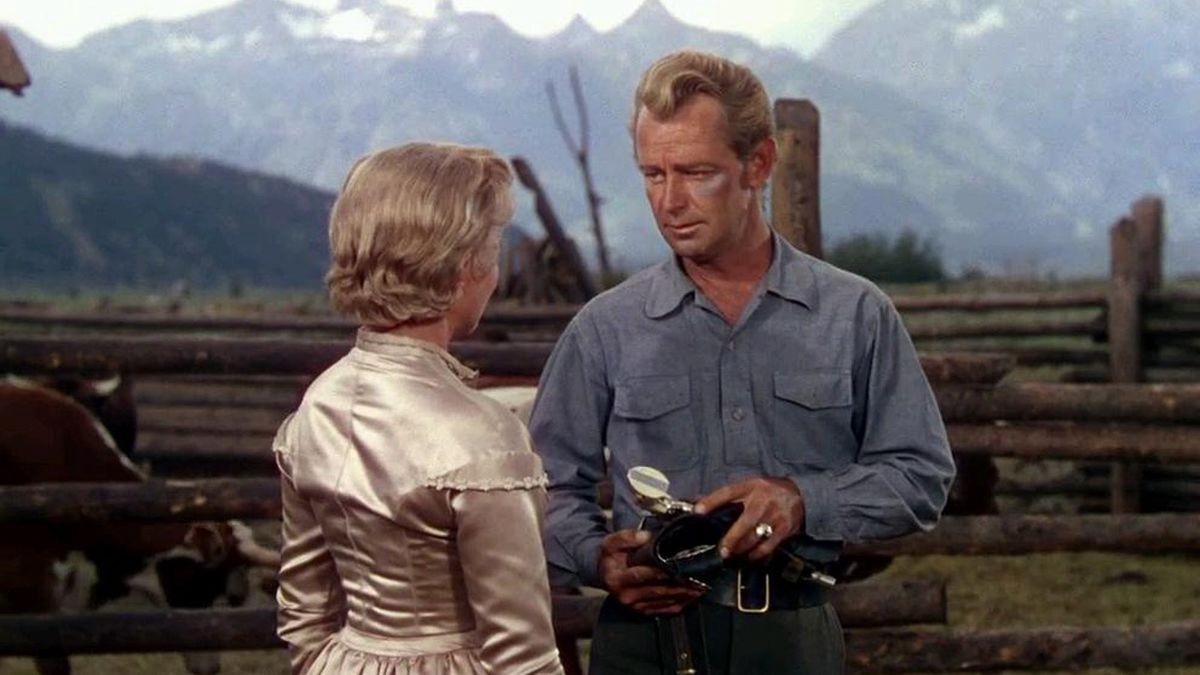 Shane. Dir. George Stevens.
Shane. Dir. George Stevens.
Coming out just a year after High Noon, Shane builds on the idea of the necessity of the righteous western hero in a world that is beginning to no longer need him. The film begins with Shane (Alan Ladd) riding into the frame with the beautiful mountains of Wyoming in the background. Shane has come to put down his gunfighter belt for good, and soon joins the Starrett family on their ranch as an extra hand. They take a liking to Shane as he assists the family?s patriarch, Joe (Van Heflin), in the removal of a troublesome tree stump in a triumphant moment of camaraderie. The young boy of the family, Joey, greatly admires Shane and his mysterious persona as a gunfighter, and begins to see him as a father figure. The peaceful life of the Starrett family is quickly interrupted as the Ryker clan, a family of cattle drivers, threaten the Starretts in an attempt to muscle them out of their property. At first, Shane attempts to abstain from the conflict and allow Joe and the other homesteaders to handle the issue themselves, but as the Rykers continue to antagonize them, and Shane, more personally, he is drawn into the conflic. All Shane wants is to leave his violent past behind him, but he is forced to again take up the mantle of gunfighter as the homesteaders? situation grows more and more desperate. The end of the film sees Shane dispatching the Rykers, and leaving the valley for good. Before he leaves, he says this to Joey: ?A man has to be what he is, Joey. Can?t break the mold. I tried it and it didn?t work for me? there?s no living with a killing. There?s no going back from one. Right or wrong, it?s a brand, and a brand sticks. There?s no going back.? Despite all his efforts, Shane cannot avoid being who he is, and the violent nature of his purpose conflicts with the peaceful lifestyle destined for the settlers of the west. Even though men like Shane are the reason peace can exist, once that peace is achieved, their presence is no longer necessary; they are left to wander back into the wild frontier from which they first arose, much like the bookending shots of Shane.
6. The Searchers (1956)
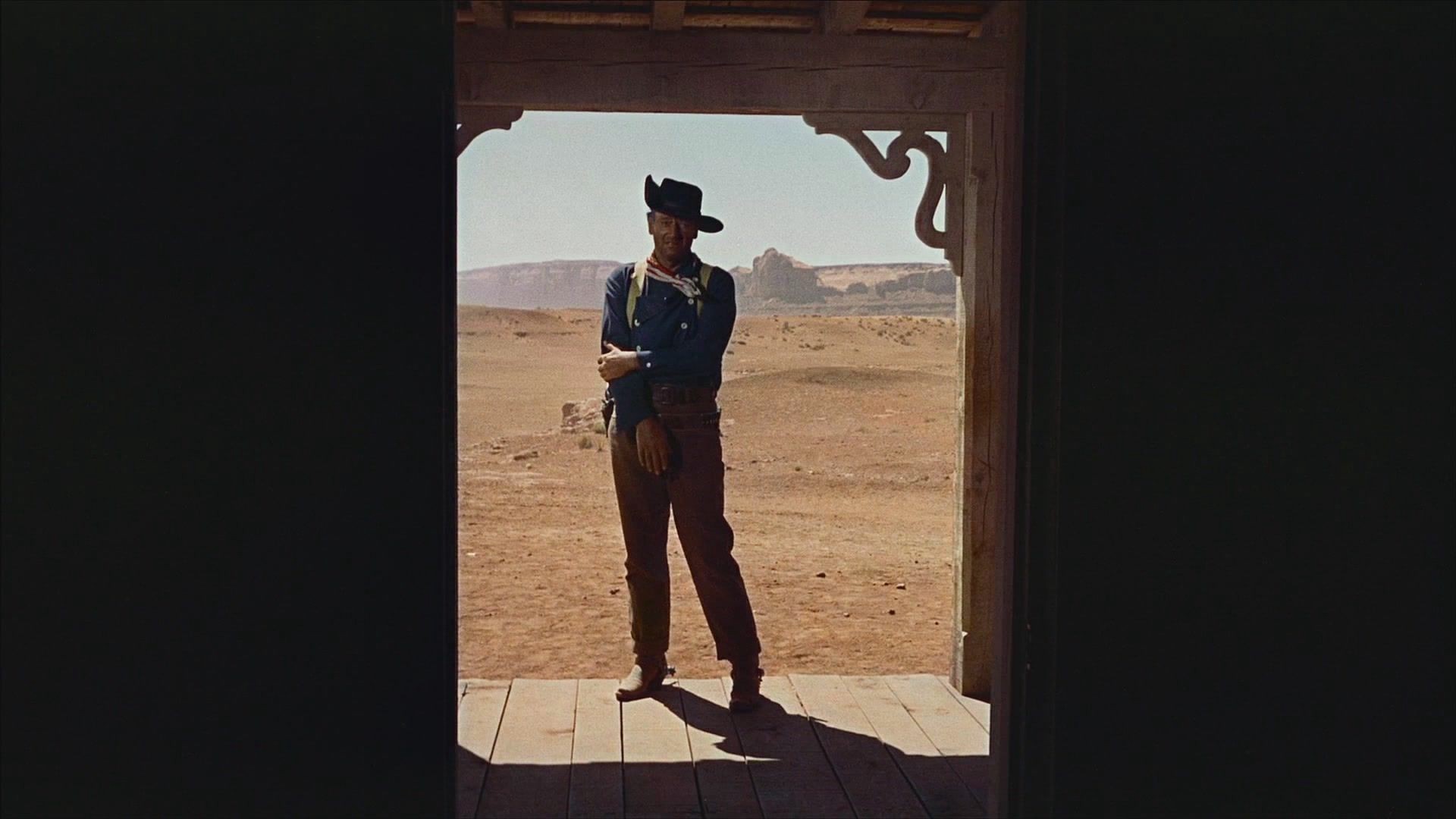 The Searchers. Dir. John Ford.
The Searchers. Dir. John Ford.
Speaking of bookending shots, The Searchers boasts a set that are even more significant than the ones in Shane. The film opens quite literally, as the door of the Edwards family swings open, revealing the beautiful vistas of Monument Valley, and a familiar man riding on a horse. John Wayne returns as the archetypal western hero, though not quite as one might expect. Immediately, the morals of Ethan Edwards are questionable, as he is dressed in the coat of a confederate soldier. His family asks where he has been since the end of the war, and it is implied that he has stolen the money he has brought along with him. His family clearly still loves him despite this, even their adopted part-Cherokee son, Martin (Jeffrey Hunter). However, this familial love is not mutual. Ethan calls Martin a ?half-breed? and treats with him nothing but disdain. They are soon bound together, though, as the Edwards? home is ravaged by a band of Comanches, led by a ruthless leader named Scar, while they are away. The Comanches kidnap the youngest daughter, Debbie, murder the rest of the family, and destroy the house. Ethan and Martin, devastated by the loss of their family, set out on an arduous ten-year journey to rescue Debbie. However, the longer she remains in the captivity of the Comanches, the more Ethan?s unbridled hatred of Indians grows. His mission soon becomes one of revenge, and comes to believe that the only salvation for Debbie is at the end of a gun. Having been part of the Comanches for years, he believes her to be fully indoctrinated, and thus no better than any of the other Comanches. Unlike in Red River, the actions of Wayne?s character here are entirely abhorrent and often racist. This may seem off-putting, but they are in fact essential to his character. The Searchers begins the idea of the revisionist western: a film that scrutinizes the heroic qualities of the western hero and the manner in which he exacts his justice. The film in many ways still glorifies Ethan?s character, but Martin plays a crucial part in offsetting his racist hatred, and guiding him to the rightful objective. In the end, despite the heroic action of Ethan, he is, much like Shane, excluded from the peaceful life of the happy family he has saved. Woefully, he saunters back into the desert, left to ?wander forever between the winds.? The film marks the end of the legacy of the western hero, as the door closes on him in the legendary final shot.
7. The Man Who Shot Liberty Valance (1962)
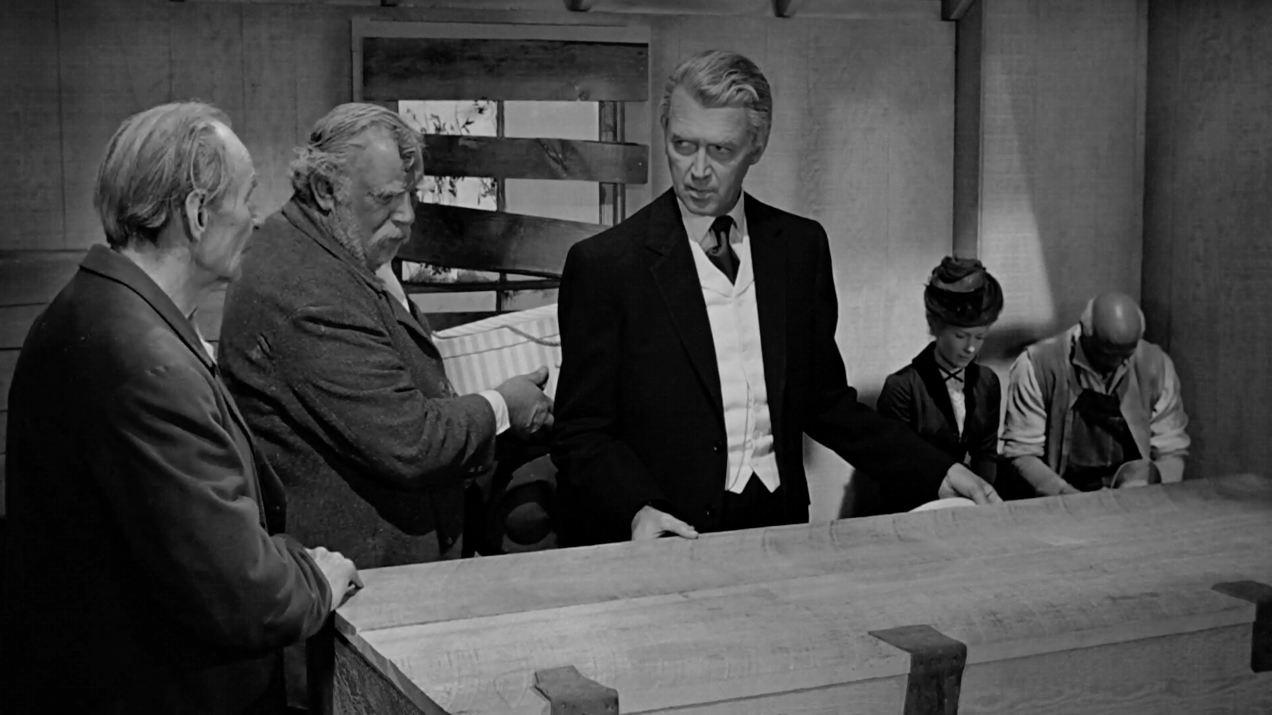 The Man Who Shot Liberty Valance. Dir. John Ford.
The Man Who Shot Liberty Valance. Dir. John Ford.
John Ford is undoubtedly the greatest purveyor of the western genre. With Stagecoach he set the standard of what a western is and how it is defined. The Searchers was his operatic ode to the end of an era. With The Man Who Shot Liberty Valance he gave a poetic send-off to the genre, romantically looking back at the men around whom the genre was built and the legacy they hold. The film starts with James Stewart and Vera Miles as aged Ranse and Halie Stoddard returning to Shinbone for the funeral of their good friend Tom Doniphon. They remark on how much the town has changed since Ranse was elected senator and departed from the town, and reminisce about old memories. The presence of their celebrity soon catches the attention of the local newspaper, and they ask the senator why he has come all this way for the simple funeral of a seemingly unremarkable man. The rest of the film plays out as a flashback, as Ranse tells the story of his arrival to Shinbone, the changes he made in the community, the people who helped him, and the titular killing that brought him fame and recognition. Lee Marvin is wonderfully despicable as the heinous Liberty Valance, who instigates the feud with Ranse when he nearly beats him to death after robbing the stagecoach he was traveling on. Ranse is rescued by the fabled Tom Doniphan, who is portrayed by none other than the immortal John Wayne. After Ranse recovers, he begins taking actions to better the town: opening a school, advocating political participation, and finding a way to bring Valance to justice. Several other confrontations between the two men occur, culminating with a tense duel in the streets. The Man Who Shot Liberty Valance is almost meta textual in the way it tells a story of a shootout that made its hero a legend, but then reveals the truth is something else entirely. What we thought we knew is wrong; the real heroes of the west have been forgotten and omitted from the stories to better fit a narrative that praises those who are more suitable for the country?s shifting needs. The western hero is dead, signified by the funeral of the man who?s actually responsible for the villain?s retribution. The Man Who Shot Liberty Valance ends its story with a message that conveys the importance of these myths, however, and how the inspiration they provide is sometimes more important than the truth. There is no better way to say it than how it was already said: ?When the legend becomes fact, print the legend.?
8. The Good, the Bad, and the Ugly (1966)
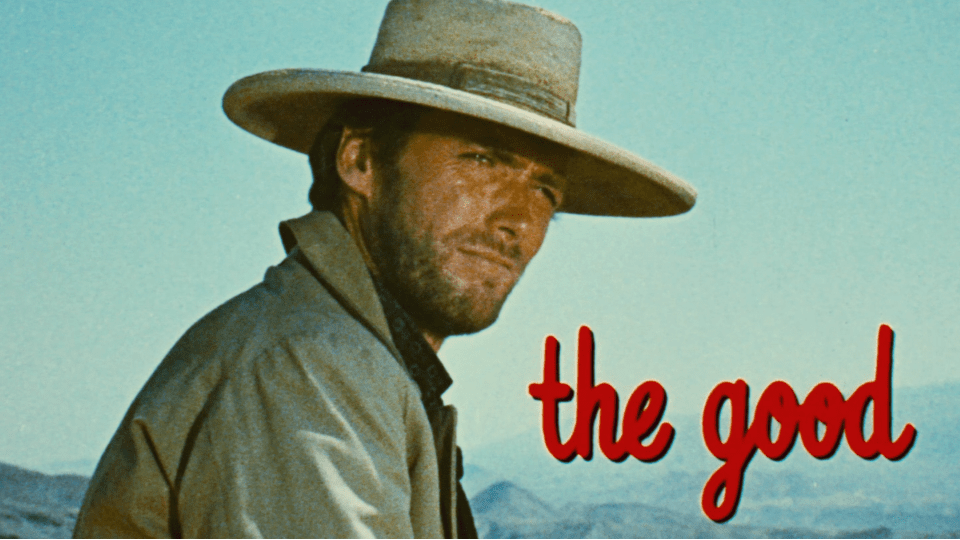 The Good, the Bad, and the Ugly. Dir. Sergio Leone.
The Good, the Bad, and the Ugly. Dir. Sergio Leone.
Though The Man Who Shot Liberty Valance gave a definitive end to the classic western hero, the genre lived on. In Italy, western films boomed, starting with Sergio Leone?s A Fistful of Dollars (1964) which revitalized the genre using a stylistic new approach. Dubbed ?spaghetti westerns,? this new breed of film radically changed perceptions of the western hero, casting him in moral shades of grey. Clint Eastwood best embodied this anti-hero figure, with his ?Man With No Name? character kick-starting his career as the new generation?s icon of the west. Instead of fighting off murderers and thieves, Eastwood?s character participated in such misdeeds himself, and without the redemptive charisma that made the outlaws of John Wayne so forgivable. The title card that introduces him as ?The Good? in this film is ironic, as it comes just as he abandons his partner in the desert, presumably to die. The film is like a reset button, turning back time to the Civil War, before most westerns were set, so that it may re-mold the genre to better represent the changing sensibilities of the mythological American West. Instead of being motivated by morality, duty, or even vengeance, the characters in The Good, the Bad, and the Ugly are motivated by their greed. A lust for gold drives each of them, as they lie, cheat, steal, and kill their way to the buried treasure. The film is very un-western in this manner, but still maintains the genres core themes of morality, even if those morals have now been skewed. Leone?s spaghetti westerns can be seen as the first true revisionist westerns, preserving the fantasy of the western hero and his rule over the land, but now without the rose-tinted glasses that led audiences to believe the actions of their heroes were always just.
9. Once Upon a Time in the West (1968)
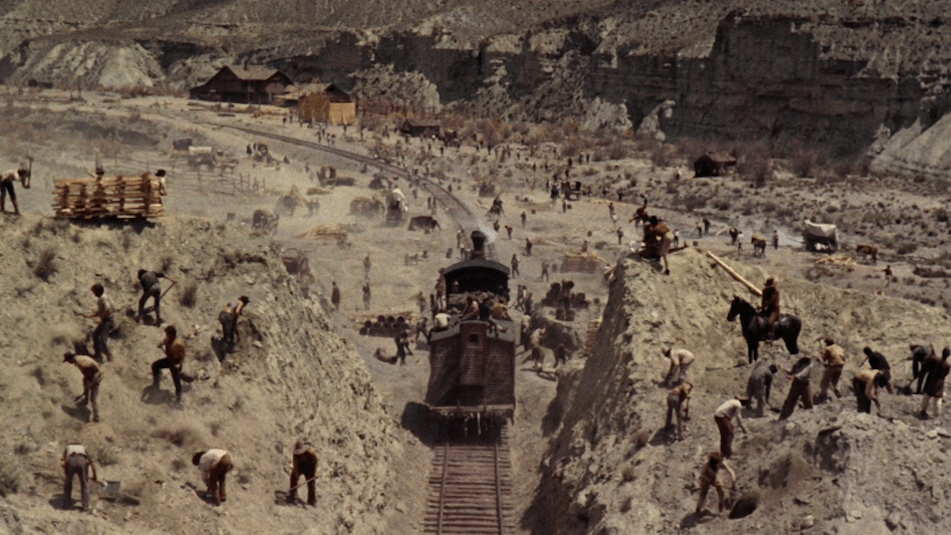 Once Upon a Time in the West. Dir. Sergio Leone.
Once Upon a Time in the West. Dir. Sergio Leone.
After Leone made The Good, the Bad, and the Ugly he considered his time with the western genre to be done. He was now ready to move on to his next great project, which would eventually become Once Upon a Time in America (1984), but American studios were pushing for him to make another western. After receiving a great offer from Paramount, Leone teamed up with Dario Argento and Bernardo Bertolucci to pen the ultimate culmination of the western genre. They took inspiration from all the great western films: three bad men waiting for a train in High Noon, a trip through Monument Valley like Stagecoach, and the omnipresent theme of the genre?s death mirroring The Man Who Shot Liberty Valance. The entire lexicon of the western filmography converges here, as Leone pulls out all the stops for his epic finale. Familiar faces from the expanse of western films populate Once Upon a Time in the West, as the film stars rugged western veteran Charles Bronson as the nameless hero. He is only referred to as ?Harmonica,? a nickname given for the way he uses the instrument to punctuate his presence in every scene. Western regulars Woody Strode and Jack Elam appear early on in a brilliant scene of silent tension building, as they ominously await the arrival of Bronson?s mysterious stranger. The most prolific western star of the picture, though, is the legendary Henry Fonda, but he?s no hero here. Leone intentionally cast Fonda against type for this subversive role, as he plays one of the most heinous villains to ever wield a six-shooter. The introduction of Frank showcases the boundless nature of his malice, as he mercilessly guns down a young boy?s entire family, before killing the boy himself. The weighted theme at the core of Once Upon a Time in the West is the impending death of the western genre. This idea is symbolized in the approaching railroad, as the threat of technology and civilized society signal the end of these lawless characters. The confrontation between Harmonica and Frank at the end of the film makes this more explicit. Harmonica says they are an ?ancient race,? and that the railroad has come to kill them off. With one final duel they put an end to the ceaseless violence that forged the western frontier, and the victor rides off, never to be seen again, just as the train pulls in to the newly built station. Once Upon a Time in the West is a western to end all westerns. It carries a sense of finality and represents everything the western genre is expected to be.
10. Unforgiven (1992)
 Unforgiven. Dir. Clint Eastwood.
Unforgiven. Dir. Clint Eastwood.
Even after Leone?s masterpiece gave the final word on the genre, westerns endured in a variety of ways. One of the many ways the genre adapted was by embracing the revisionist perspective Leone had introduced, and implemented it in a way that scrutinized the debauchery of their characters. Almost 30 years after Clint Eastwood first donned the iconic poncho of the famous western anti-hero, he stepped into the role one last time to give a definitive retrospective look at the character and the way in which we immortalize the western hero. Unforgiven is unlike just about every western before it in how incredibly cynical it is about the genre. There is not even a hint of heroism here, as even the seemingly noble deeds driving the plot is carried out by men who are as vile as those they seek to eradicate. Eastwood stars as William Munny, a reformed murderer of women and children, who once again takes up the mantle so that he may collect a bounty in the town of Big Whiskey. Concurrently, we are shown the activities proceeding Munny?s arrival to Big Whiskey, namely, the arrival of notorious gunman ?English Bob? and his biographer, who is chronicling the stories of Bob?s triumphs. This memoir is revealed to have been exaggerated after Bob is arrested by the town?s sheriff, Little Bill Daggett, who then informs the biographer of the bogus nature of Bob?s exploits. The scene of Little Bill deconstructing the myth of English Bob?s fabricated identity as a western legend is a microcosm of the film as a whole. Unforgiven reveals the truth of the western heroes: many of them would shoot a man in the back given the chance and luck was often a more crucial factor than skill. Even the men meant to represent the law are corrupted, as Little Bill tortures a man to death without remorse. When Munny arrives at the bar to exact vengeance, he mercilessly guns down all in his path. After decorating the bar with the blood of his opponents, he departs, but not without a warning to everyone else, first: ?Any man I see out there, I?m gonna shoot him. Any sumbitch takes a shot at me, I?m not only gonna kill him, but I?ll kill his wife, all his friends, and burn his damn house down.? As much as we like to pretend the west was a land where good morals prevailed above all, Unforgiven is a blunt reminder of the kind of brutality and dishonor that really took place during the colonization of the American west.
Honorable Mentions:
The extensive scope of the western genre made for a difficult curation of only ten films. There are countless others that also aided in shaping and refining the genre as well, that there was unfortunately not enough room to include them in the official list. Here are five other notable western films that stand as paragons of the genre and also deserve a share of recognition.
- The Ox-Bow Incident (1943): A thrilling western-drama that sees Henry Fonda attempting to keep the peace between an angry lynch mob and three accused cow-thieving murderers. The harrowing true story leaves the audience constantly questioning the validity of the accused?s testimony and the ethics of taking the law into your own hands. With an unforgettable ending, the scales of morality are heavily weighed here.
- 3:10 to Yuma (1957): The Elmore Leonard novel of a rancher tasked with escorting notorious villain Ben Wade to the eponymous train is filled with gorgeously expressionistic lighting, blurring the line between good and bad in the same way the charismatic outlaw attempts to charm his way out of custody. Starring Glenn Ford in a rare antagonistic role, the film is a gripping ride from beginning to end.
- The Wild Bunch (1969): Sam Peckinpah?s explosive revisionist western remains one of the most powerful entries in the western genre. Set in 1913, the mythic west has more or less died out, and the titular band of outlaws teams up for one last score on their way into the grave. Starring William Holden, Ernest Borgnine, and a slew of veteran western actors, Peckinpah delivers a classic western with its own iconic take on the end of an era.
- McCabe & Mrs. Miller (1971): Robert Altman brings his signature subversive touch to the western genre with this antithetical film. Warren Beatty stars as John McCabe who, despite his reputation with a gun, is a cowardly sleaze, very much unlike typical western heroes. Altman crafts a film that is intentionally opposite of the genre, while still managing to capture the western mentality in his tried and true revisionist manner.
- Red Sun (1971): A unique blend of the western genre and samurai film, which itself was birthed from early John Ford films. This features another starring appearance from Charles Bronson representing the western hero, and the iconic image of the cinematic samurai himself: Toshir Mifune. The two pair perfectly as an unlikely couple who learn to work together in this lighting in a bottle concoction of a film.
To fully appreciate and understand the western genre is a massive undertaking. After existing for more than 100 years it has been realized in every which way, and all shapes and sizes. Despite any attempts at killing off the genre for good, western films are still seeing quite a bit of success. Just recently, films like The Hateful Eight (2015), The Magnificent Seven (2016), and last year?s Hostiles (2017) have proven that there is still a demand for the genre in a variety of different interpretations.The western genre will always reflect our feelings of justice and morality, either in how those when needed will rise to the occasion, or in the failures of society when cowardice overtakes us. Regardless, they both send the same message: people are at their best when they stand together to protect the innocent and ward off villainy. It is the responsibility of the individual to stand up for what is right and be an example for others to follow. Without good people fighting to keep these ideals alive, the world will become a lawless land ruled by vicious oppressors. The day will be won by those who stick to their principles, and steadfastly implore others to do the same. When times are tough, and defeat feels certain, the western genre shines like a beacon to remind us that goodness can triumph, even in the most dire times.
